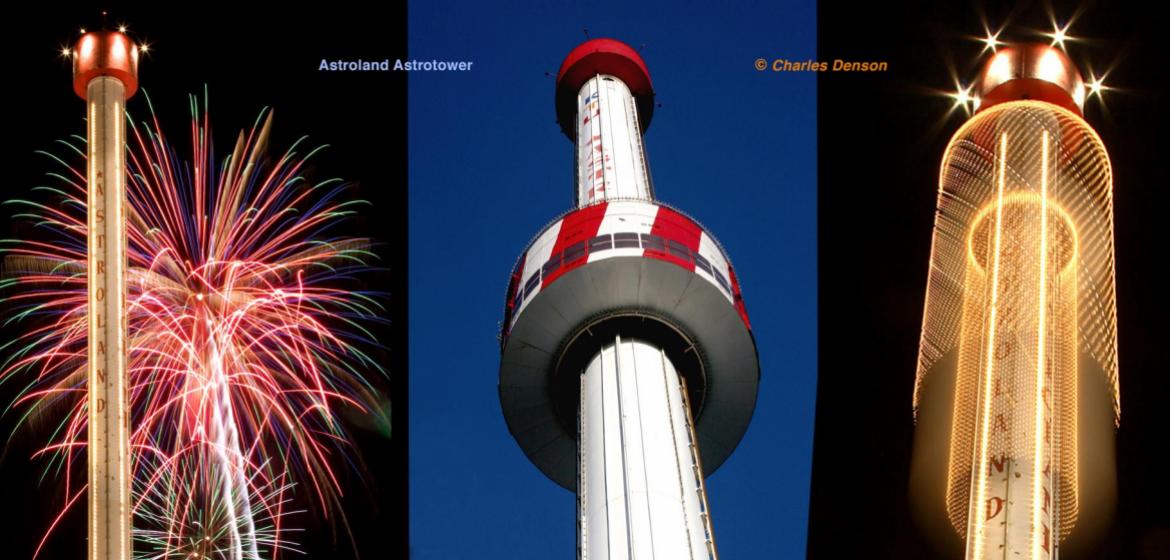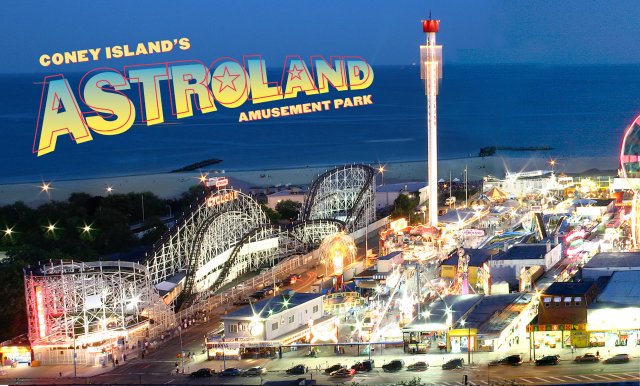
Photo: © Charles Denson
"Astroland Park, created at the dawn of the space age, mirrored the wide-eyed optimism of the early 1960s and helped Coney Island survive the closure of Steeplechase Park," writes Charles Denson in Coney Island and Astroland.
On Saturday, September 8, the Coney Island History Project will open special hours to commemorate the 10th anniversary of the closing of Astroland Park, Deno's Wonder Wheel Park will have a free movie screening in the Astroland Rocket, and former Astroland employees are hosting an Astroland Reunion in Coney Island.
From now through September 29, the public is invited to enter the Coney Island History Project's Astroland Remembered Photo Contest on our websiteEnter the Astroland Remembered Photo Contest! and Facebook page. Share your favorite photos of yourself, family and friends at Astroland taken anytime from 1962 through 2008. Winners will receive an autographed copy of Coney Island and Astroland and a Coney Island History Project Walking Tour for you and three of your friends. Winning photos will be exhibited at the Coney Island History project next season on Coney Island's Opening Day!
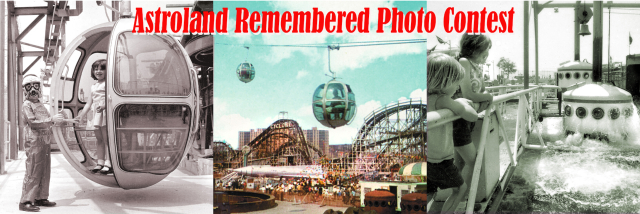
Photos: © Coney Island History Project/ Astroland Archives
Astroland fans, friends and former employees are invited to visit the Coney Island History Project's exhibit center on September 8 from 1-5 PM to view historic artifacts, banners, signage and photos of Astroland's unique attractions including the Astrotower, Diving Bell, Rocket and Sky Ride. Admission is free of charge. Visitors may record their memories of Astroland for our oral history archive and bring photos to reminisce over and scan for our collection. The Coney Island History Project was founded in 2004 by Carol Hill Albert and Jerome Albert in honor of Dewey Albert, creator of Astroland Park.
Ten years after the legendary park's closing, the heritage continues at the Coney Island History Project and Deno's Wonder Wheel Park. In 2014, the History Project teamed up with the Vourderis family, owners of Deno's Wonder Wheel Park, to bring back the iconic Astroland Rocket, which has a new home adjacent to the Wonder Wheel. Originally built as the "Star Flyer," the Rocket was the first ride at Astroland and defined the park's space age theme when it opened in 1962. As one of the first of the "imaginary" space voyage simulators constructed during the Space Race, the attraction showed simulator films of "rocket rides" while the chassis "rocked" its viewers to outer space.
On September 8, from 12-6 PM, visitors are invited to sit in one of the Rocket's 26 seats and watch the movie The Rocket Has Landed. The 18-minute film by Charles Denson tells the history of the Astroland Rocket and its journey back to Coney Island after being damaged by Hurricane Sandy while in storage on Staten Island. Admission to the Rocket and movie screenings will be free of charge. The giant gorilla from Astroland's Dante's Inferno has also found a new home, outside Deno's Spook-A-Rama, and stands ready to pose for souvenir photos.
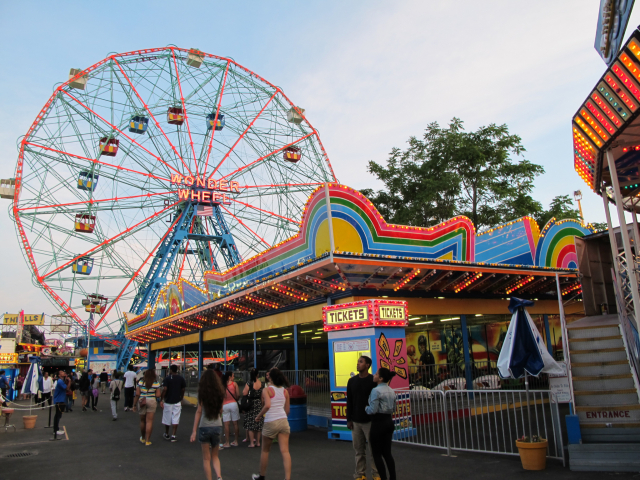
Photo: © Jim McDonnell
When Astroland closed, its rides went to parks around the world and one of the stars from its Surf Avenue gate joined the collection of the Smithsonian's National Air and Space Museum. Deno's Wonder Wheel Park's Barbieri bumper cars, the largest bumper car ride in New York City, is the only Astroland ride currently in operation in Coney Island. Go for a nostalgic spin under its magical rainbow-hued pavilion located adjacent to the Wonder Wheel. For ticket info, visit Deno's website. Deno's Wonder Wheel Park is open daily through Labor Day, and on weekends and school holidays through the end of October.
A group of former Astroland employees has organized a September 8th reunion with a BBQ and music from 2-7 PM at the Unknown Bikers Club on Coney Island's Bowery, next to the Nets store. All former Astroland employees and friends as well as the public are welcome to attend. Donation is $10 at the door. For information, visit the Facebook event page.
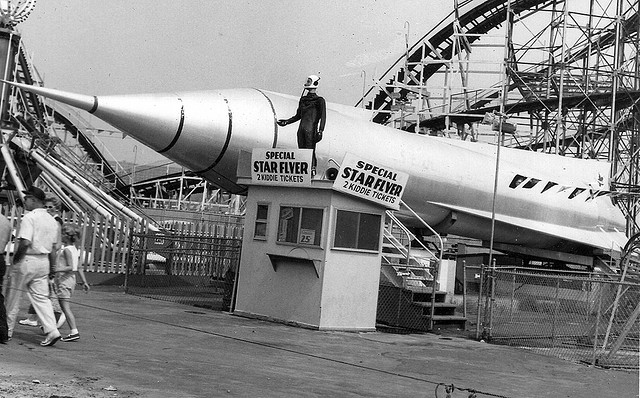
Photo: © Coney Island History Project/ Astroland Archives
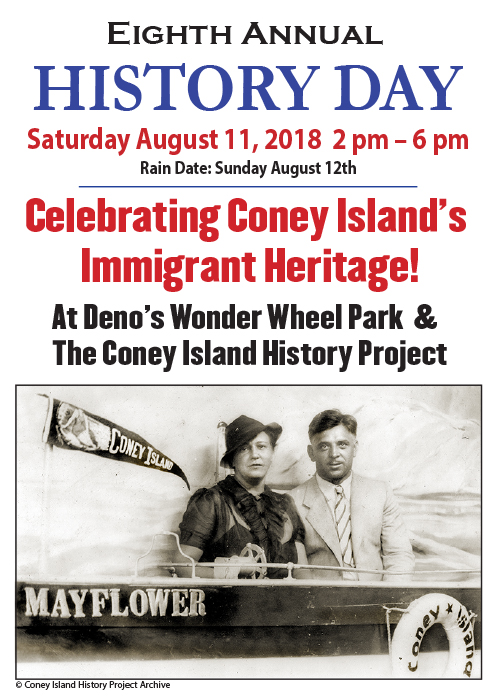
[POSTPONED] We're sorry, due to the rainy forecast on Saturday, August 11, and on Sunday, we are postponing our 8th annual History Day event for this weekend. We plan to reschedule it and hope you will join us then. Sign up for our e-news (link at bottom of page) or follow us on social media for updates!
[UPDATE] 8th Annual History Day is rescheduled for June 9, 2019!
Eighth Annual History Day
Saturday, August 11th, 2pm-6pm
Rain Date: Sunday August 12th
Celebrating Coney Island's Immigrant Heritage!
At Deno's Wonder Wheel Park and
The Coney Island History Project
Free Live Music, Entertainment and History!
Hosted by Deno John Vourderis, Deno's Wonder Wheel Park and
Charles Denson, Coney Island History Project
In the early 20th century Coney Island's most popular souvenir photo-stand props consisted of small boats named The Mayflower. Recent immigrants could pose as Mayflower passengers, freedom-seekers celebrating liberty on the shores of the World's Playground.
For more than a century, Coney Island served as the true historic "melting pot" for New York City's immigrant population. It remains a place of great diversity, where people of small means enjoy an affordable day of free recreation on the beach and Boardwalk. Coney Island continues to be a destination for immigrants, the place to assimilate with people of all nationalities. It's where they finally find true freedom and become Americans.

Enjoy History Day performances by musicians and dancers representing the traditional culture of countries from which people have emigrated to Coney Island:
Mariachi Real de Mexico de Ramon Ponce - New York's premier mariachi - 3:00PM
Brighton Ballet Theater School of Russian Ballet - Local students from school founded by Irina Roizin perform classical ballet and Ukrainian folk dance - 3:30PM
Paolo Buffagni - Modena-born tenor moved to New York to take up a career in opera and lives in Sunset Park - 4:00PM
New York Music and Dance Organization - Bensonhurst-based Chinese dance troupe founded by Julia Liu - 4:30PM
Gaston "Bonga" Jean-Baptiste - Master Haitian drummer - 5:00PM
-Plus DJ Joe Gonzalez, special guests and table top displays representing New York City's immigrant diversity including the Mayor's Office of Immigrant Affairs, Center for Traditional Music and Dance, Brighton Ballet Theater School of Russian Ballet and New York Music and Dance Organization. Desert Island, a store in Brooklyn featuring illustration and comic art from around the world, will distribute free copies of their Coney Island-themed issue of Smoke Signal.
-Record the names and memories of your family's first visit to the World's Playground and scan their photos for the Oral History Archive at the Coney Island History Project
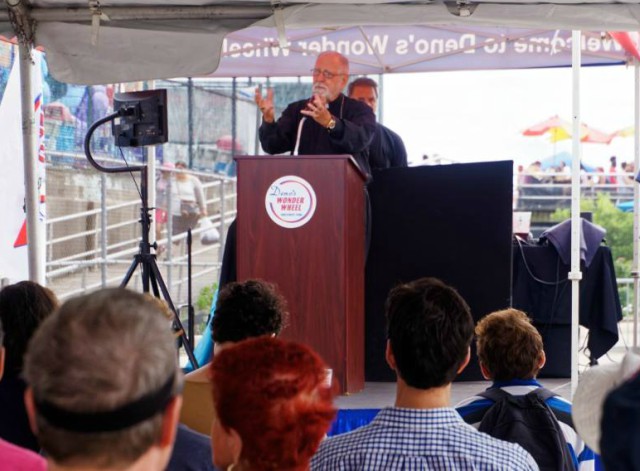
- On History Day, Father Eugene Pappas, Coney Island native and pastor of Southern Brooklyn's Three Hierarchs Greek Orthodox Church for the past 35 years, will broadcast a live radio show from Deno's Wonder Wheel Park about Coney Island's immigrant heritage. The radio show will be from just after 1pm until 2pm on WNYE COSMOS FM Hellenic Public Radio and will be followed by his opening remarks at 2pm on the Dreamland Plaza Stage. Guests on the radio show will include Dennis Vourderis of Deno's Wonder Wheel Park and Charles Denson of the Coney Island History Project. Tune in at 91.5 or listen live at cosmosfm.org/podcast.
The opening ceremony at 2pm will be followed by Free Live Entertainment from 3-6pm on the Dreamland Plaza Stage located at 3059 West 12th St next to Deno's Wonder Wheel Park (between Bowery Street and Boardwalk).
About Deno's Wonder Wheel Park
Built in 1920, Deno's Wonder Wheel is the iconic centerpiece of the Coney Island skyline and the heart and soul of the amusement and entertainment district. Deno's Wonder Wheel Park founder Denos D. Vourderis, the 8th of 22 children, immigrated to the United States at age 14 to pursue the American Dream. He was born in Greece in 1920, the same year as the Wonder Wheel that he would buy in 1983 as a wedding ring for his wife, restore to its original state and build his park around. Deno's Wonder Wheel Park has the best selection of rides for kids and over 21 thrilling attractions including the classic haunted house dark ride, Spook-A-Rama, and Stop the Zombies, a state-of-the-art virtual reality interactive ride, game and movie in one air-conditioned theater. The park is owned and operated by Dennis and Steve Vourderis and their sons, the second and third generations of the Vourderis family. Deno's Wonder Wheel was designated an official New York City landmark in 1989 and West 12th Street, between Surf Avenue and the Boardwalk, was co-named Denos D. Vourderis Place in 2001. Deno's Wonder Wheel will celebrate its 100th birthday in 2020.
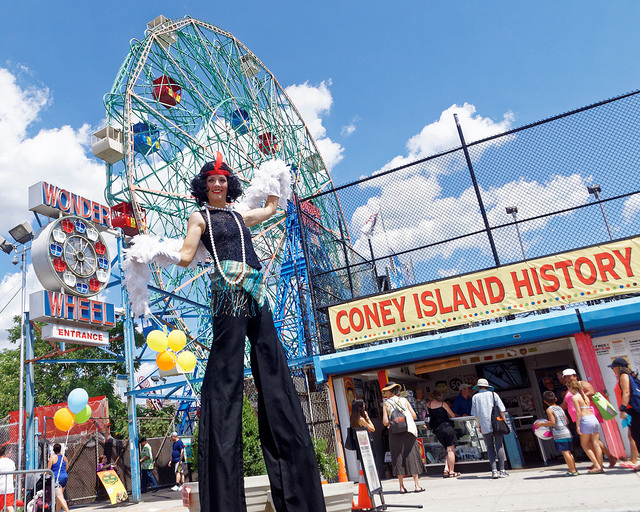
About the Coney Island History Project
The Coney Island History Project is a not-for-profit organization that aims to increase awareness of Coney Island's legendary past and to encourage appreciation of the Coney Island neighborhood of today. Located on West 12th Street at the entrance to Deno's Wonder Wheel Park, our exhibition center is open free of charge on weekends during the summer season. Emphasizing community involvement, the History Project records and shares oral history interviews; provides access to historical artifacts and documentary material through educational exhibits, events and a website; and teaches young people about local history and develops programs in conjunction with local schools, museums, and other organizations. Our multilingual offerings include a brochure in 10 languages, English and Chinese language walking tours, and oral history interviews recorded in several languages. The Coney Island History Project was founded in 2004 by Carol Hill Albert and Jerome Albert in honor of Dewey Albert, creator of Astroland Park. Executive director Charles Denson is a Coney Island native, a noted historian, and the author of the award-winning book Coney Island: Lost and Found.
Deno's Wonder Wheel Park and the Coney Island History Project
3059 West 12th Street, Coney Island, Brooklyn, NY 11224
D, F, N or Q train to Stillwell Terminal
Phone: 347-702-8553 (Coney Island History Project)
Phone: 718-372-2592 (Deno's Wonder Wheel Park)
http://www.coneyislandhistory.org
http://www.denoswonderwheel.com
events[AT]Coneyislandhistory[DOT]org
 The Coney Island History Project's programs are supported in part by public funds from the NYC Dept of Cultural Affairs in partnership with the NYC City Council, New York City Councilman Mark Treyger, and our members and contributors.
The Coney Island History Project's programs are supported in part by public funds from the NYC Dept of Cultural Affairs in partnership with the NYC City Council, New York City Councilman Mark Treyger, and our members and contributors.
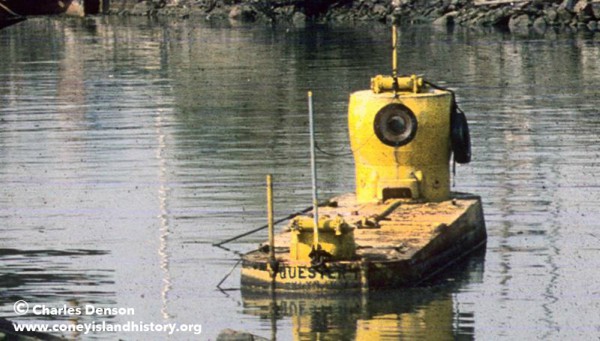
Coney Island Creek's Yellow Submarine Quester I. Photo © Charles Denson
What can we learn about New York City and its waterfront from its boats? Stefan D-W of the Waterfront Alliance's Waterwire is inviting those across the maritime world and beyond-historians, planners, artists, business people, scientists- to share their perspectives on NYC History in 10 Boats. Below is the sixth installment, with Charles Denson, reprinted from Waterwire, with additional photos from the Coney Island History Project's Collection.
Iolas
Ferry service to Coney Island began in the summer of 1845 when the steamboat Iolas left the Battery at 7am and arrived at the western tip of the island about an hour later. The little ferry made four trips a day to the dune-covered sand bar that would soon become “The Playground of the World.”
Shamrock
Coney Island’s little-known connection to the America’s Cup was centered at the island’s Atlantic Yacht Club at the mouth of Coney Island Creek where, in 1899, Sir Thomas Lipton’s Irish racing yacht Shamrock was berthed while competing in the world-famous event being held in New York Harbor. The Shamrock was defeated in all three races by the New York Yacht Club’s defender, Columbia.
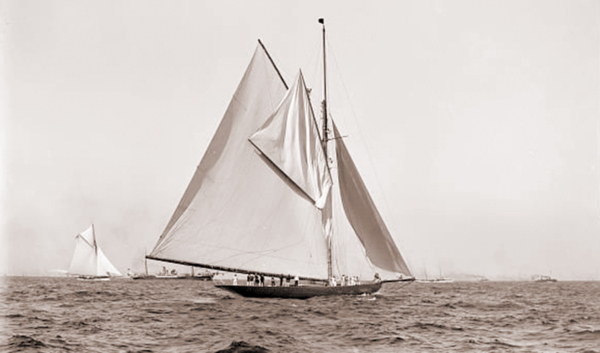
Saranac
The wreck of the three-masted wooden schooner Saranac became a popular “ghost ship” attraction after it ran aground and was abandoned alongside the Steeplechase Pier in Coney Island around 1907. Steeplechase owner George C. Tilyou decided not to remove the wreck and instead decorated the ship’s masts and rigging with colorful flags, advertising it as a monument to the last days of proud sailing ships.
Flying Dutchman
During the early days of Prohibition, Coney Island Creek was a main landing point for rumrunners. Many yachts built at the Wheeler Shipyard were modified into rumrunners that could outrun police boats and revenue cutters patrolling offshore. In September 1923, a 40-foot modified cruiser named Flying Dutchman partook in a dramatic, three-mile gun battle with police before beaching at Coney Island Creek. One of the Dutchman’s crew was shot by police, four others were arrested, and the boozy contents of the boat was taken to police headquarters at the Battery.
Noah’s Ark
The whimsical vessel was actually a nautical-themed funhouse on the Boardwalk in front of Steeplechase Park during the 1920s and 1930s. After entering through the gaping mouth of a blue whale, visitors navigated a maze that led to encounters with captain “Noah” and his animal pairs while the entire attraction rocked back and forth.
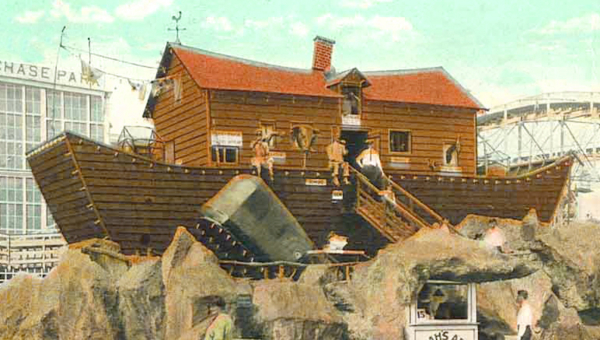
Hemingway’s Pilar
Ernest Hemingway’s famous 38-foot deep-sea fishing boat, the Pilar, was built on Coney Island Creek at the Wheeler Shipyard in 1934. Hemmingway’s fishing adventures on the Pilar became the inspiration for his novels The Old Man and the Sea, and Islands in the Stream. The boat is now on display at Finca Vigia, the Hemingway Museum in Havana, Cuba.
Gold Star Mother
Gold Star Mother was a Staten Island ferryboat, one of three with feminine names launched in 1937. The name came from the “Gold Star” honor and flag awarded to mothers of soldiers killed in battle during World War I. The ferry, one of the first to be fueled with oil rather than coal, was in service for several decades before being retired and transformed into a floating methadone clinic. The vessel was towed to Coney Island Creek where it was eventually dismantled for scrap in 1975.
Wheeler Patrol Boats
The Wheeler Shipyard on Coney Island Creek built and launched 230 patrol boats used by the U.S. Coast Guard during World War II. The 83-foot wooden craft served in all theaters of war, and many are still in use today as private fishing boats.
Coney Island Creek’s Yellow Submarine
Quester I is a homemade submarine, built on Coney Island Creek in 1970 by Jerry Bianco, a Brooklyn Navy Yard welder. Bianco hoped to raise the Andrea Doria, an ocean liner that sank in the Atlantic in 1956. After taking the sub on several successful test runs in Gravesend Bay, Bianco was unable to raise the funds to continue his salvage project and the sub was abandoned. It broke loose of its moorings in a storm and now lies as a famous wreck at the mouth of Coney Island Creek.
New York City Department of Environmental Protection’s Snowy Egret
Snowy Egret is a 45-foot marine skimmer that began operation in 1997 as part of a citywide floatables containment program. The vessel appears after heavy rainfall to skim up tons of Coney Island trash washed into the creek’s sewer outfalls during summer storms.
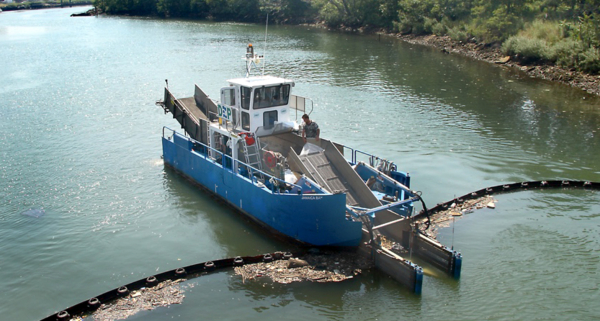
Astroland's Astrotower Photos by Charles Denson
What's in a name? It depends. I've been asked my opinion about naming new Coney Island attractions after old ones, specifically the name "Astrotower," which is being co-opted by Luna Park to use on their newest ride. The other names in question are Luna Park, Thunderbolt, Steeplechase, and Feltmans. In theory it shouldn't matter, and if it were anywhere else but Coney Island, few people would care. These names, however, carry a lot of weight because of the dramatic way in which they met their demise.
The original Luna Park and original Feltmans were failed businesses when they ended their long runs. And there were reasons for their failures. They had outlived their glory days and, like other older attractions, failed to change with the times. Luna Park is a generic name that was used all over the world. Coney's original 1903 Luna was actually named "Thompson & Dundy's Luna Park." The founders were proud of their creation. I could never figure out why Zamperla didn't add their own name to the new park — it was as if they were embarrassed by it. Using a new name or adding a twist to the name would have been a step forward instead of a confusing step backward. The media and the public are often confused as to whether the old and new parks are the same.
In 2010 Zamperla USA President Valerio Ferrari told the New York Daily News that he decided on the Luna Park name after "devouring" my book, Coney Island Lost and Found. I didn't think reviving the name was the best idea, but in the end it didn't really matter, as Coney Island seemed to be moving forward. At the time, the Coney Island History Project put together an extensive, celebratory exhibit about Luna Park history and I wrote an op-ed piece in the Daily News about how beautiful and exciting it was to see the spectacular lighting on Luna's new entrance. I was no fan of Luna's corporate mindset but I was curious to see where it would go and we welcomed them.
Valerio was friendly and gave me free rein to document the park's construction, but that soon came to an end. When Luna Park tried to evict two historic businesses on the Boardwalk, I was interviewed by the Wall Street Journal and frankly expressed my displeasure. Valerio was pissed off and told me that I was "too loud." I had to remind him that I didn't work for Luna Park, and that to me it was personal, not business. These Boardwalk people were my friends and their livelihoods would be ruined. I realized that the city's plan for a single operator was in the works and that this was the beginning of a process to wipe the slate clean. I had little to do with Luna Park after that. Following a public outcry, the two businesses were allowed to stay and were given new leases.
As far as using the Feltmans name, the only thing I can say is that if you're actually making the greatest hot dog in the world, a new and delicious product, then why not put your own family name on it? Be proud of your accomplishment and write a new chapter! Publicity and competition with Nathans can only take one so far.
There is an inherent problem with naming new attractions after old if you are not truly reviving the original but just copying the name. Renaming is a reductionist ploy that doesn't honor or pay tribute to something historic. Steeplechase, Thunderbolt, and Astrotower were all destroyed in horrible ways that are still traumatic to anyone who knew the real thing.
Fred Trump's sadistic demolition of the Steeplechase Pavilion, which included partygoers hurling bricks through the stained glass windows of the pavilion, is still a horrifying memory to those who loved the place. It's kind of creepy to see the name tacked onto a ride that has no relation to the original. It makes no sense.
The Thunderbolt Roller Coaster was ordered demolished by Mayor Giuliani, who repeatedly lied about his involvement until forced to admit under oath in court that he personally and illegally gave the orders. It was a real abuse of power, and the demolition still brings up bad memories of the stubborn battle between owner Horace Bullard and the authoritarian mayor. I wrote the last-minute landmark application for the structure and remember the Landmarks Preservation Commission's refusal to even look at it. Whether you loved or hated the old ruin, it should not have been illegally demolished. The reproduced signage on the new coaster is a constant reminder of abuse of power in Coney Island.
The new "Thunderbolt" coaster uses the name and signage, but where's the old hotel below it? The old Thunderbolt was special: historic and eccentric, expressing the quirkiness of the real Coney Island. The new tubular coaster is a great attraction and people love it, but what does it have to do with the original? Nothing! Why not come up with a new name? Putting an old picture of the real T-Bolt in the ticket box is a nice touch, but it has no context and context is everything when it comes to history.
That brings us to the Astrotower. You don't have to be an old-timer to recall what happened to that landmark. The wounds are still fresh, and the city's condemnation and demolition of the tower was a Fourth of July fiasco that will go down in infamy. There is no need to detail the bizarre events that led up to the dramatic emergency dissection of the beloved Astroland icon, but it should be obvious that using its name for another attraction is kind of tone deaf and antagonizes those who feel that it's inappropriate. The general public may not care because, after all, they come to Coney for fun, not to dwell on the past or politics. Many think it's not a big deal. I told Luna that using the Astrotower name was not a good idea and that I was not the only one who felt that way. Carol Hill Albert, whose late husband built the original tower, was not too happy about it either. There are other creative ways to pay homage to attractions from the past.
Sometimes it's better to leave something alone. You can dig up a corpse but it's impossible to bring it back to life. It's called grave robbing and just makes a mess. There's a good reason that you don't see many new cruise ships named "Titanic."
Childs Restaurant, B&B Carousell, Cyclone, and Parachute Jump all represent real history as well as the future, and Zamperla controls three of these landmarks. Isn't that enough? Luna Park has given the public a slick and exciting ride showroom with a beautiful gate. The old Luna was about exotic fantasy architecture and "weird whimsy." The new one is more about business and efficiency.
A couple of months ago I was approached by the new management of Luna Park after Valerio Ferrari left the company, and invited to sit down with them to discuss history. We had a long, cordial meeting. I also spoke with their branding consultant and gave my unbiased opinion about Coney Island's future. It seems as if they're open to new ideas. I'm not big on corporate environment and feel much more comfortable and at home at Deno's Wonder Wheel Park, with it's family dynamic and historic atmosphere — to me that's the authentic Coney Island that I grew up with.
Context is an important component to history, and learning about the past does not have to be academic. The Coney Island History Project's stated mission is not about nostalgia, which is longing for a past that never was. We're interested in what endures and why, and how it will work in the future. I hope that the Boardwalk leases will be renewed. I hope that the old businesses that have endured will survive and work together to preserve Coney's heritage while moving into the future. That would be truly historic.
– Charles Denson
UPDATE:
I was encouraged by the dialogue generated by my story about nostalgia. I'd like to add a simple example of a successful way to honor Coney Island History. That would be Coney Island USA's Mermaid Parade! This beloved annual rite harkens back to the old Coney Island Mardi Gras, a tradition that defined Coney Island for half a century before coming to an end in 1954.
When CIUSA revived the idea of a parade, a new name and theme were chosen and they created a magical event with roots in a long-gone Coney Island ritual. There was no recycling of a name from the past. The media recognizes the origins of the Mermaid Parade when reporting about it and this eliminates confusion or controversy. That's what's meant by context. Respect the past, but create something new and build on it. Use creativity and you will succeed.
So many old-timers who still remember the Mardi Gras have come to the History Project to share their vivid memories and to express their joy at seeing the spirit of the old event continue as the Mermaid Parade. This is amazing considering that the last Coney Mardi Gras parade last took place more than 60 years ago!
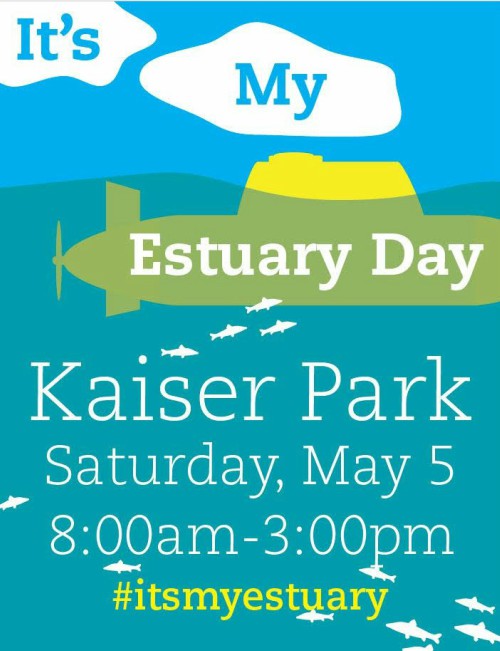
You're invited to the 4th annual It's My Estuary Day on Saturday, May 5, from 8:00AM-3:00PM, a day of service, learning and celebration along Coney Island Creek in Kaiser Park! The free event will include underwater robotics, oyster monitoring, diving demonstrations, water chemistry techniques, seining, microscope viewing of plankton, displays by environmental organizations, host talks, coastal clean up, lunch and networking.
Featuring over 40 partner organizations, this annual community event is organized by the Cultural Research Divers, BMSEA (Brooklyn Marine STEM Education Alliance), and NYSMEA (NY State Marine Education Association), and hosted by Making Waves, a coalition of stewards caring for Coney Island Creek and Kaiser Park, of which the Coney Island History Project is a member.
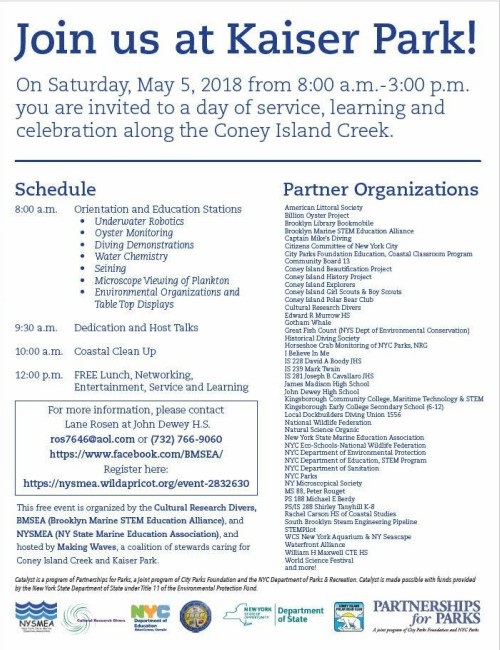
Stop by the Coney Island History Project's table to learn about our free programs, including the new exhibit "Coney Island Creek and the Natural World," opening Memorial Day Weekend. Pick up a copy of the Coney Island CreekWalk at Calvert Vaux Park booklet produced by the History Project for Partnerships for Parks. We'll have bilingual interviewers in attendance to record your stories in English, Russian and Chinese about the neighborhood and the Creek for our Oral History Archive. Visitors may also take a self-guided walking tour by following the markers created by the Charles Denson of the Coney Island History Project for CreekWalk at Kaiser Park.
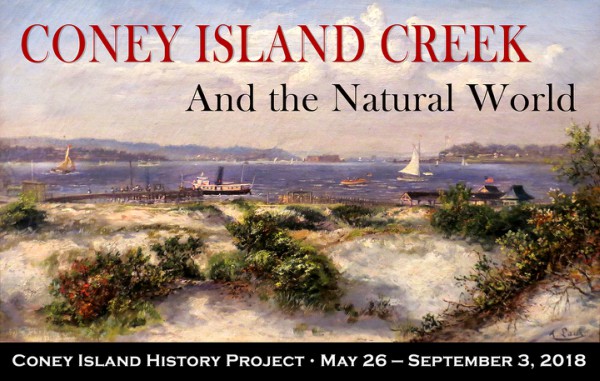
The Coney Island History Project's special exhibition for the 2018 season, opening Memorial Day Weekend and on view through Labor Day, is "Coney Island Creek and the Natural World." Coney Island is best known for its magnificent artifice, a manufactured reality and fantasy world that replaced the vibrant natural environment of sand dunes and salt marshes that existed before development began 200 years ago.
Very little of that environment has survived. The towering sand dunes were flattened, and the wetlands were filled in for development leaving the island vulnerable to storms. Even the island's world-famous beach is artificial, created with sand hydraulically pumped from offshore shoals. 19th century painters and photographers were able to capture images of a beautiful landscape that was about to be transformed forever as an isolated sandbar was transformed into the "World's Playground."
Ironically, the much-maligned estuary known as Coney Island Creek has become a key to understanding what was lost to development and what can be restored for future generations. The creek and its parks represent the true essence of Coney Island. Once a pristine salt marsh consisting of more than 3,000 acres of wetland habitat, Coney Island Creek was the original attraction at Coney Island, attracting anglers, hunters, writers, and artists to hotels along the creek's shoreline.
For the 2018 season we are planning a multi-media exhibit, curated by Charles Denson, called "Coney Island Creek and the Natural World" consisting of maps, photographs, posters, art, artifacts, oral history, and video. Among the rare treasures on display is Coney's "first admission ticket," the wooden 1823 sign from the Creek's Shell Road toll house advertising the rates for horse and rider and coaches. It is Coney Island's oldest surviving artifact and part of our permanent collection.
The exhibit describes the flora and fauna of the island's environment as well as recent environmental projects that are restoring habitat once lost to development and pollution. Through the lens of history, art, and ecology, we will explore Coney Island's transformation and why it's important not to repeat the mistakes of the past.
The Coney Island History Project exhibition center is open free of charge on Saturdays, Sundays and holidays from Memorial Day Weekend through Labor Day from 1:00PM-7:00PM. We're located on West 12th Street at the entrance to Deno's Wonder Wheel Park, just a few steps off the Boardwalk. View historic artifacts, photographs, maps, ephemera and films of Coney Island's colorful past. Visitors are invited to take free souvenir photos with the iconic Spook-A-Rama Cyclops and an original Steeplechase horse from the legendary ride that gave Steeplechase Park its name. The History Project is open year-round for our weekend walking tours and group visits, and for oral history interviews.
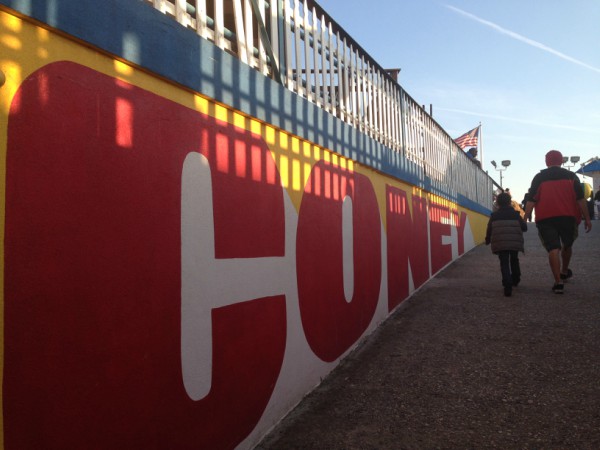
There's lots to do from spring through the beginning of summer in CONEY ISLAND!
Here's the Coney Island History Project's selected list of FREE upcoming events in the community:
April 12 - "Rise above the Tide" Community Imagination Workshop, Coney Island YWCA
April 16 - Chess Workshop, Coney Island Library (Mondays thru May 21)
April 21 - Family Day Block Party, Coney Island YWCA
April 21 - Immigrant Heritage Walking Tour in English and Mandarin, Coney Island History Project
April 23 - Senior Education Day, Coney Island Anti Violence Collaborative
May 5 - 4th Annual It's My Estuary Day, Kaiser Park
May 13 - Mother's Day Karaoke, Deno's Wonder Wheel Park
May 13 - Horseshoe Crab Monitoring, Kaiser Park (May 13-June 30)
May 26 - Coney Island Beach Re-opens for Swimming
May 26-28 - Exhibit Center Season Opener, Coney Island History Project
June 3 - Coney Island Reggae on the Boardwalk
June 9 - 8th Annual Pet Day & Costume Contest, Deno's Wonder Wheel Park
June 16 - 36th Annual Mermaid Parade, Coney Island USA
June 17 - Father's Day Karaoke, Deno's Wonder Wheel Park
June 22 - Coney Island's First Fireworks Show of 2018 (Fridays thru August 31)
June 22 - Fireworks Friday Karaoke, Deno's Wonder Wheel Park (Fridays thru August 31)
For Coney news, events, conversation, photos and special features like "On This Day in History,"
follow the Coney Island History Project on Facebook, Twitter and Instagram.
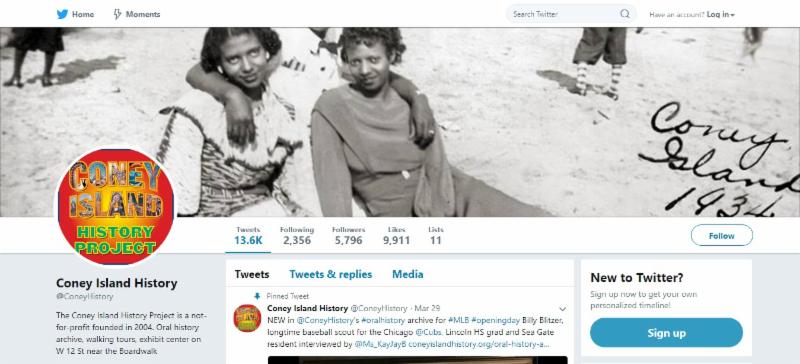
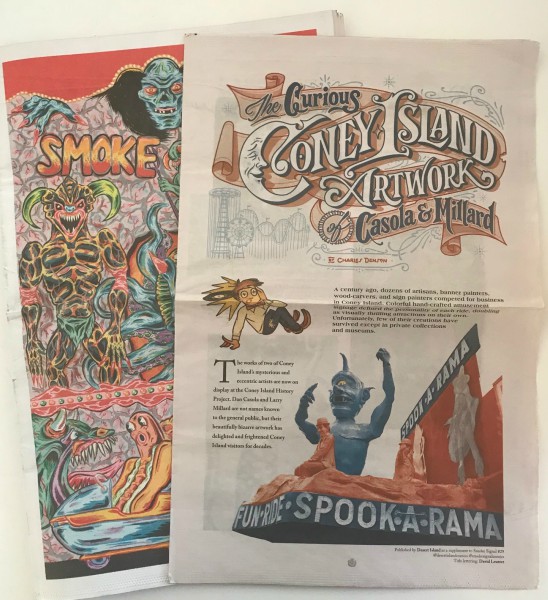
Charles Denson's essay "The Curious Coney Island Artwork of Casola and Millard," excerpted below, appears in the new issue of Smoke Signal, with lettering by David Leutert, published by Desert Island Comics. The Coney Island themed-magazine is available free in their store, at 540 Metropolitan Avenue in Brooklyn, or via mail order. The Coney Island History Project will be distributing free copies at our exhibit center this summer.
A century ago, dozens of artisans, banner painters, wood-carvers, and sign painters competed for business in Coney Island. Unfortunately, few of their creations have survived except in private collections and museums.
The works of two of Coney Island's mysterious and eccentric artists are now on display at the Coney Island History Project. Dan Casola and Larry Millard are not names known to the general public, but their beautifully bizarre artwork has delighted and frightened Coney Island visitors for decades.
DAN CASOLA
Dan Casola's sideshow banners command astronomical prices from collectors if you can find one. Less known are Casola's sculptural works and painted signs. Casola created the iconic Spook-A-Rama Cyclops from Denos Wonder Wheel Park, a work of art that recently toured the country as part of a traveling Coney Island art exhibit that ended at the Brooklyn Museum. For three decades the horned monster, with its rotating glowing eye, stood guard over Coney Island's Bowery.
Italian immigrant Dan Casola was a self-taught artist with a twisted sense of humor. His stylized billboards, signage, wax figures, fire-breathing dragons, and animated mechanical figures were fixtures across Coney Island. He worked out of storefront studios on Surf Avenue and later from his home on Stillwell Avenue. His largest canvas was the Spook-A-Rama dark ride. During the 1950s, at the height of the monster movie craze, he covered the ride's block-long facade with dozens of humorous hand-painted signs and animated figures including the iconic Cyclops.
Casola had an eye for the ladies and ran several burlesque "Girlie Shows" on the Bowery during the 1940s. His daughter, Patricia, recalls his artwork being heavy on the "boobs and butts." She also remembers growing up in a house full of "glass eyeballs, plaster heads, and boxes of hair" that he used for his animated creations. Her mother's lingerie would disappear and later turn up on spook house figures. "He had this very interesting side to him," she says. Indeed.
LARRY MILLARD
The mural-covered interior of the Playland Arcade on Surf Avenue delighted patrons for many decades, yet few knew the story behind the whimsical artwork covering every inch of the establishment. Playland closed in 1983, and the building stood empty until it was demolished in 2013. Fifteen years ago the Coney Island History Project began an ambitious project to document and preserve the rapidly deteriorating cartoon murals and to tell the story of the artist who created them. It became an uphill battle against vandals, thieves, and Hurricane Sandy, but finally the story can be told.
In the winter of 1957 a mysterious artist named Larry Millard showed up at the Playland Arcade looking for work. The 45-year-old Millard claimed to have been a cartoonist for the New York Daily News and offered his services as a sign painter. Playland owner Alex Elowitz hired him to paint several Skeeball signs. His lettering was stylish and perfect, and he soon expanded his work to include cartoon characters and humorous narratives. Millard worked tirelessly through the summer of 1958, painting larger and more colorful murals on every inch of wall space.
Millard was a heavy drinker who followed a daily routine. He arrived early in the morning unshaven and smelling of alcohol, suffering from the shakes. After he purchased a bottle of Thunderbird wine at the liquor store next to Mama Kirsch's restaurant, his hands would become steady enough to draw.
Stanley Fox, whose brother Alex owned the arcade, described Millard as “artsy looking,” with dark hair and a mustache, always wearing a fedora and usually accompanied by his girlfriend, an African-American woman named Eunice. Millard would arrive daily with sketches to be approved by Elowitz. “My brother paid him by the day, maybe $25. Larry lived somewhere in Coney Island, although no one was sure where.”
Millard’s later work consisted of complex cartoons illustrated with puns and jokes: busty, leggy women with hapless boyfriends. Many of his murals were in the cartoon style of Lil’ Abner creator Al Capp. The public loved his work, and he continued painting Playland until every wall was filled. After finishing up at Playland, he began painting outdoor signs around Coney Island and more murals at Stauch’s Baths and the B&B Carousel.
Millard disappeared from Coney Island in 1960 and was never seen again. He left his mark on Coney Island, works that served as petroglyphs: deceivingly simple yet undecipherable and opaque. Beneath the inherent humor in his pieces, it’s possible that most of his sketches were actually self-portraits telling his life story: the tale of a tortured soul, a gambler who had bad luck with women. --Charles Denson
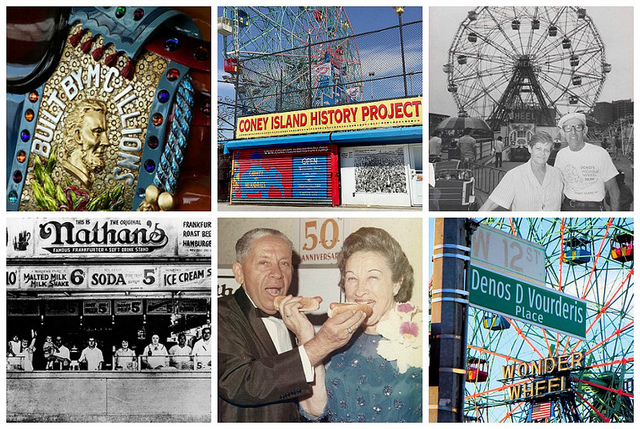
On Saturday, April 21, 2018, learn about the contributions of immigrants to the history and development of "The Playground of the World" on our Immigrant Heritage Tour of Coney Island (康尼岛移民遗产之旅) conducted in English (12:00 PM) and (Mandarin 3:00 PM). The Coney Island History Project is offering this special walking tour as part of Immigrant Heritage Week 2018. Tickets are free of charge for the 1-1/2 hour, wheelchair accessible tour but must be reserved online as each tour is limited to 40 participants. Advance ticketing is available via our online reservation page on Eventbrite. If you have a question, please email events@coneyislandhistory.org.
Among the stops on the walking tour and the stories of struggle, success and achievement are Nathan's Famous, founded in 1916 by Polish immigrant Nathan Handwerker; Deno's Wonder Wheel Amusement Park, where the landmark 1920 Wonder Wheel was purchased by Greek immigrant Denos D. Vourderis as a wedding ring for his wife; and the B&B Carousell, created in 1919 by German and Russian immigrants and now Coney's last hand-carved wooden carousel.
Coordinated by the Mayor's Office of Immigrant Affairs, Immigrant Heritage Week is an annual citywide program of events celebrating the history, traditions and contributions of New York City's diverse immigrant communities. This year's IHW is scheduled for April 16-22 in recognition of April 17, 1907, the date when more immigrants entered the U.S. through Ellis Island than any other date in history. The theme for Immigrant Heritage Week 2018 is "A City of Immigrants: United in Action." Click here to download a pdf brochure of events from the city's website.
"Coney Island has traditionally been a place where immigrants who wanted to start a business could start small and work their way up," says Charles Denson, director of the Coney Island History Project. "A person of small means with no experience or capital could lease a stall on the Bowery and open a game concession with nothing more than a few baseballs and milk bottles. Coney was also the place where immigrant families could escape steaming tenements, get fresh air, bathe in the ocean and assimilate with people of all nationalities. It's where they finally found true freedom and became Americans."
The walking tour will also highlight businesses operated by immigrants from Hong Kong, Jamaica, Mexico, Turkey and Ukraine who have recorded their stories for the Coney Island History Project's Oral History Archive. The Immigrant Heritage Tour will be led by Tricia Vita and Sylvia Ching Man Wong, who facilitate and record oral histories for the Coney Island History Project.
The Coney Island History Project, founded in 2004, is a 501(c)(3) not-for-profit organization that aims to increase awareness of Coney Island's legendary and colorful past and to encourage appreciation of the Coney Island neighborhood of today. Our mission is to record, archive and share oral history interviews; provide access to historical artifacts and documentary material through educational exhibits, events and a website; and honor community leaders and amusement pioneers through our Coney Island Hall of Fame.
This program is supported, in part, by the New York City Department of Cultural Affairs in partnership with the City Council, and New York City Councilman Mark Treyger, and our members and contributors.

